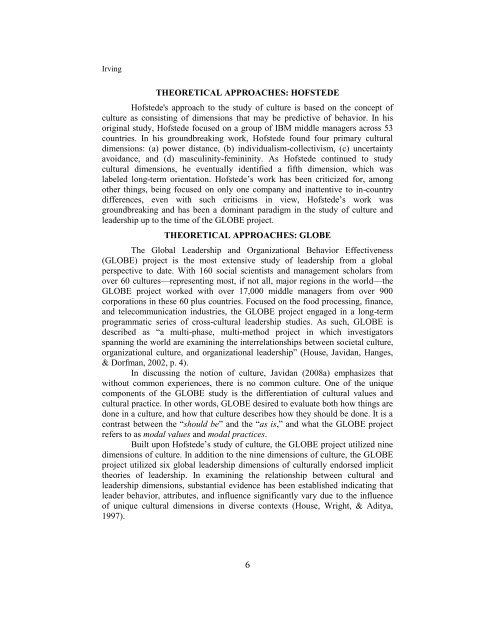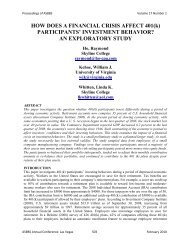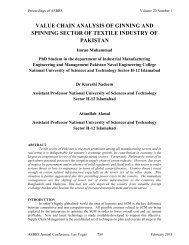journal of business and educational leadership - Asbbs.org
journal of business and educational leadership - Asbbs.org
journal of business and educational leadership - Asbbs.org
Create successful ePaper yourself
Turn your PDF publications into a flip-book with our unique Google optimized e-Paper software.
Irving<br />
THEORETICAL APPROACHES: HOFSTEDE<br />
H<strong>of</strong>stede's approach to the study <strong>of</strong> culture is based on the concept <strong>of</strong><br />
culture as consisting <strong>of</strong> dimensions that may be predictive <strong>of</strong> behavior. In his<br />
original study, H<strong>of</strong>stede focused on a group <strong>of</strong> IBM middle managers across 53<br />
countries. In his groundbreaking work, H<strong>of</strong>stede found four primary cultural<br />
dimensions: (a) power distance, (b) individualism-collectivism, (c) uncertainty<br />
avoidance, <strong>and</strong> (d) masculinity-femininity. As H<strong>of</strong>stede continued to study<br />
cultural dimensions, he eventually identified a fifth dimension, which was<br />
labeled long-term orientation. H<strong>of</strong>stede‘s work has been criticized for, among<br />
other things, being focused on only one company <strong>and</strong> inattentive to in-country<br />
differences, even with such criticisms in view, H<strong>of</strong>stede‘s work was<br />
groundbreaking <strong>and</strong> has been a dominant paradigm in the study <strong>of</strong> culture <strong>and</strong><br />
<strong>leadership</strong> up to the time <strong>of</strong> the GLOBE project.<br />
THEORETICAL APPROACHES: GLOBE<br />
The Global Leadership <strong>and</strong> Organizational Behavior Effectiveness<br />
(GLOBE) project is the most extensive study <strong>of</strong> <strong>leadership</strong> from a global<br />
perspective to date. With 160 social scientists <strong>and</strong> management scholars from<br />
over 60 cultures—representing most, if not all, major regions in the world—the<br />
GLOBE project worked with over 17,000 middle managers from over 900<br />
corporations in these 60 plus countries. Focused on the food processing, finance,<br />
<strong>and</strong> telecommunication industries, the GLOBE project engaged in a long-term<br />
programmatic series <strong>of</strong> cross-cultural <strong>leadership</strong> studies. As such, GLOBE is<br />
described as ―a multi-phase, multi-method project in which investigators<br />
spanning the world are examining the interrelationships between societal culture,<br />
<strong>org</strong>anizational culture, <strong>and</strong> <strong>org</strong>anizational <strong>leadership</strong>‖ (House, Javidan, Hanges,<br />
& Dorfman, 2002, p. 4).<br />
In discussing the notion <strong>of</strong> culture, Javidan (2008a) emphasizes that<br />
without common experiences, there is no common culture. One <strong>of</strong> the unique<br />
components <strong>of</strong> the GLOBE study is the differentiation <strong>of</strong> cultural values <strong>and</strong><br />
cultural practice. In other words, GLOBE desired to evaluate both how things are<br />
done in a culture, <strong>and</strong> how that culture describes how they should be done. It is a<br />
contrast between the ―should be‖ <strong>and</strong> the ―as is,‖ <strong>and</strong> what the GLOBE project<br />
refers to as modal values <strong>and</strong> modal practices.<br />
Built upon H<strong>of</strong>stede‘s study <strong>of</strong> culture, the GLOBE project utilized nine<br />
dimensions <strong>of</strong> culture. In addition to the nine dimensions <strong>of</strong> culture, the GLOBE<br />
project utilized six global <strong>leadership</strong> dimensions <strong>of</strong> culturally endorsed implicit<br />
theories <strong>of</strong> <strong>leadership</strong>. In examining the relationship between cultural <strong>and</strong><br />
<strong>leadership</strong> dimensions, substantial evidence has been established indicating that<br />
leader behavior, attributes, <strong>and</strong> influence significantly vary due to the influence<br />
<strong>of</strong> unique cultural dimensions in diverse contexts (House, Wright, & Aditya,<br />
1997).<br />
6
















